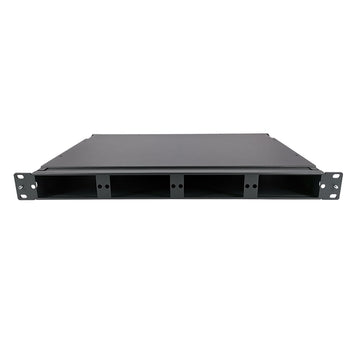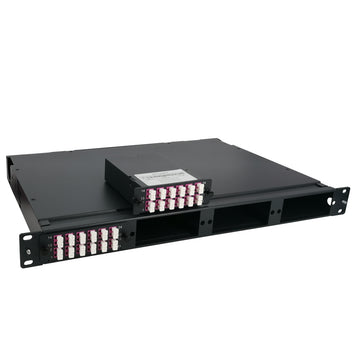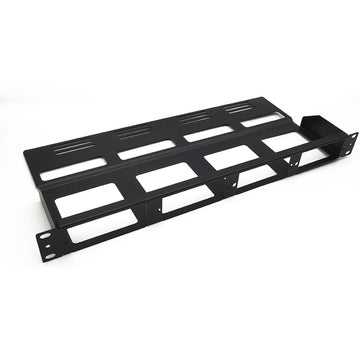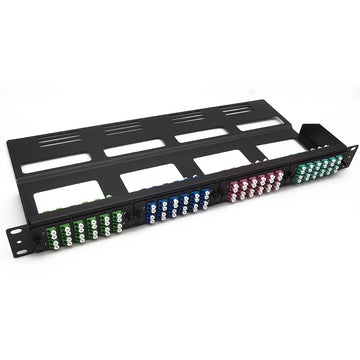Quickview about SFP, SFP+, SFP28, QSFP+, QSFP28, QSFP-DD and OSFP
Optical modules play a key role in the data communication industry, SFP, SFP+, SFP28, QSFP+, QSFP28, QSFP56, QSFP-DD and OSFP are different optical transceiver types. And all of them are hot-pluggable network interface modules used for connecting a network switch and other networking devices (such as a server or media converter) for data transmission.
Then, SFP vs SFP+, SFP28 vs SFP+, QSFP vs QSFP28 vs QSFP56 vs QSFP-DD vs OSFP, what are the differences? Is QSFP28 compatible with QSFP+? Can I use SFP28 transceiver in SFP+ ports? Is QSFP28 compatible with QSFP-DD? Are QSFP28 and QSFP56 compatible? This post will offer explanations.
Introduction on the Types of Transceivers
Before figuring out the difference in SFP vs SFP+, SFP28 vs SFP+, or QSFP vs QSFP28, it’s necessary to know what SFP, SFP+, SFP28, QSFP+, QSFP28, QSFP56, QSFP-DD and OSFP are.
SFP (small form-factor pluggable) , also know as mini-gbic (gigabit interface converter). An SFP module is simply a small modular transceiver that plugs into an SFP port on a network switch or server. SFP module has replaced the GBIC module in most applications because of its small size, allowing it to be used in tight networking spaces to provide fast communication between switches and important networking components. And, SFP module is hot-pluggable, which makes it easy to adjust existing networks without having to redesign the entire cable infrastructure. Meanwhile, SFP is a popular industry format supported by many network component vendors.
SFP+ (small form-factor pluggable plus) is an enhanced version of the SFP. It supports 8 Gbit/s Fibre Channel, 10 Gigabit Ethernet and Optical Transport Network standard OTU2. SFP+ also introduces direct attach for linking two SFP+ ports without additional fiber transceivers, including DAC (direct attach cable) and AOC (active optical cable), which are quite brilliant solutions for the short-distance direct connection between two adjacent network switches. The applications have expanded to include SONET OC-192, SDH STM-64, OTN G.709, CPRI wireless, 16G Fibre Channel, and the emerging 32G Fibre Channel application.
SFP28: 25 Gbit/s
SFP28 (small form-factor pluggable 28) is an enhanced version of SFP+, which complies with multiple standards and specifications such as IEEE802.3, SFF-8472, SFF-8402, SFF-8432 and SFF-8431. SFP28 has the same common form factor as the SFP+, but supports 25Gb/s over a single lane. SFP28 provides a new way for networking upgrade: 10G-25G-40G-100G, which is an energy-efficient solution to meet the growing demands of next-generation data center networks.
QSFP+ (Quad Small Form-Factor Pluggable Plus) is an evolution of QSFP (quad small form-factor pluggable). QSFP can carry 4 channels simultaneously and each channel can handle 1 Gbit/s data rate- hence the name Quad SFP. Unlike QSFP, QSFP+ supports 4x 10 Gbit/s channels. And the 4 channels can be combined into a single 40 Gigabit Ethernet link. The QSFP+ transceiver can replace 4 standard SFP+ transceivers, resulting in greater port density and overall system cost savings over traditional SFP+ products. Nowadays, QSFP+ gradually replace QSFP and is widely used by people as it can provide higher bandwidth.
QSFP+ is an evolution of QSFP (quad small form-factor pluggable). QSFP can carry 4 channels simultaneously and each channel can handle 1 Gbit/s data rate- hence the name Quad SFP. Unlike QSFP, QSFP+ supports 4x 10 Gbit/s channels. And the 4 channels can be combined into a single 40 Gigabit Ethernet link. The QSFP+ transceiver can replace 4 standard SFP+ transceivers, resulting in greater port density and overall system cost savings over traditional SFP+ products.
QSFP56: 200 Gbit/s
QSFP56 is designed to carry 200 Gigabit Ethernet, HDR InfiniBand, or 64G Fibre Channel. The biggest enhancement is that QSFP56 uses four-level pulse-amplitude modulation (PAM-4) instead of non-return-to-zero (NRZ). It uses the same physical specifications as QSFP28 (SFF-8665), with electrical specifications from SFF-8024 and revision 2.10a of SFF-8636. Sometimes this transceiver type is referred to as "200G QSFP" for sake of simplicity.
SFP-DD: 200 Gbit/s and 400 Gbit/s
The small form-factor pluggable double density (SFP-DD) multi source agreement is a standard published in 2019 for doubling port density. According to the SFP-DD MSA website: "Network equipment based on the SFP-DD will support legacy SFP modules and cables, and new double density products." SFP-DD uses eight lanes to transmit.
QSFP-DD: 400 Gbit/s and 800 Gbit/s
QSFP-DD (also called QSFP56-DD) stands for Quad Small Form Factor Pluggable Double Density, which is fully compliant with IEEE802.3bs and QSFP-DD MSA standards. It supports 400Gb/s (8x50G) or reach up to 800Gb/s. As the smallest form factor for 400G transceivers, QSFP-DD is widely used by people as it can provide higher bandwidth.
OSFP: 400 Gbit/s and 800 Gbit/s
OSFP is a new pluggable form factor with eight high speed electrical lanes that will initially support 400Gb/s (8x50G) or reach up to 800Gb/s. The width, length and thickness of QSFP-DD are 18.35mm, 89.4mm and 8.5mm, while those of OSFP are 22.58mm, 107.8mm and 13.0mm. It is obvious that the OSFP form factor is slightly wider and deeper than the QSFP-DD, but it still supports 36 OSFP ports per 1U front panel, enabling 14.4Tb/s per 1U.
Comparisons
After figuring out what SFP/SFP+/SFP28/QSFP+/QSFP28/QSFP56/QSFP-DD/OSFP are, the following part will give detailed comparisons of SFP vs SFP+, SFP28 vs SFP+, QSFP vs QSFP28 and SFP28 vs QSFP28.
SFP vs SFP+: Same Size with Different Speed and Compatibility
Simple to understand, SFP+ is an updated vision of SFP, both are virtually identical in size and appearance. SFP usually support 1.25Gbit/s to 4.25 Gbit/s while SFP+ supports data rates up to 10 Gbit/s. When it comes to SFP vs SFP+, they have the same size and appearance, but in a different standard which SFP is based on IEEE802.3 and SFF-8472. Besides, they comply with different specifications. SFP is based on SFF-8472 protocol, and SFP+ conforms to SFF-8431 and SFF-8432. And in terms of SFP vs SFP+ compatibility, SFP+ ports often accept SFP optics but at a reduced speed of 1 Gbit/s. And SFP+ transceiver can not be plugged into an SFP port, otherwise, the product or port may be damaged.
QSFP+ vs SFP+: Different Size and Different Speed
The primary difference between QSFP and SFP is the quad form. QSFP+ is an evolution of QSFP to support four 10 Gbit/s channels carrying 10-Gigabit Ethernet, 10G Fiber Channel, or InfiniBand, which allows for 4x 10G cables and stackable networking designs that achieve better throughput.
SFP+ vs SFP28:Same Structure and Interface Standard
SFP28 and SFP have the same structure definition and interface standard, but the rate of SFP28 reaches 25Gbps, and the transmission efficiency is 2.5 times higher than that of SFP+. At present, the price of 40G optical transceiver modules and 100G optical transceiver modules is too high, and the power consumption is too large, and the speed of 10G optical transceiver modules cannot meet the needs of the network, so the 25G SFP28 optical transceiver modules just makes up for the shortcomings between the three. At the same time, in 5G communications, SFP28 transceiver modules will be widely used in fronthaul networks.
QSFP28 vs SFP+: Different sizes and working principles
SFP+ and QSFP28 transceivers actually adopt different sizes and working principles. SFP+ supports only one channel with 10 Gbit/s, while QSFP28 supports 4 separate lanes, and each is 25 Gbit/s.
SFP28 vs QSFP28: Work on Different Principles
Though there is a number “28” in their names, SFP28 and QSFP28 transceiver actually adopt different sizes and working principles. SFP28 supports only one channel with 25 Gbit/s, while QSFP28 supports 4 separate lanes, and each is 25 Gbit/s. Both of them can be used in 100G networks, but the SFP28 is applied in the form of QSFP28 to SFP28 breakout cables. The following shows a direct connection for 100G QSFP28 to 4x SFP28 DAC.
QSFP-DD vs QSFP28: Different Structure, Different rates and Different Protocol Standards
Even thougth the QSFP-DD has the same width, length, and depth as the QSFP28 with 18.35mm, 89.4mm and 8.5mm, while QSFP-DD module has an 8-lane electrical interface instead of a 4-lane and the ASIC ports of the QSFP-DD are doubled to accommodate prevailing interfaces such as CAUI-4. Therefore, the mechanical interface of QSFP-DD on the host board is slightly deeper than that of the other QSFP system transceivers to accommodate the extra row of contacts.
The QSFP-DD modules can support 400Gbps while QSFP28 can only reach 100Gbps. QSFP-DD is fully compliant with IEEE802.3bs and QSFP-DD MSA standards and the data rate of each channel can reach 25Gb/s through NRZ modulation technology to realize 200G network transmission. Also, the data rate of each channel can reach 50Gb/s by the PAM4 modulation technology, achieving 400G network transmission.
QSFP-DD vs QSFP56: Different Bandwidth & Application
QSFP-DD and QSFP56 belong to the QSFP form factor, but QSFP-DD modules can support 400Gbps while QSFP56 can only reach 200Gbps. Therefore, QSFP-DD connectors are used in 400G optical modules, DACs and AOCs, and applied for the 400G data center interconnections. And QSFP56 modules and DAC/AOC are used for 200G networks interconnection.
Conclusion
SFP vs SFP+ vs SFP28 vs QSFP+ vs QSFP28 vs QSFP56 vs QSFP-DD, all their differences in the various types of transceivers have been stated clearly in this article. Though some of them share the same design, they are designed for different data rates. And from the comparisons, it’s clear that the main driving force behind the evolution of optical transceivers is the need to achieve higher bandwidth rates with smaller form-factor. We believe that the rapid development of QSFP-DD will greatly benefit on the whole optical interconnect and communication industry. Let’s wait and see what will happen in the future.












